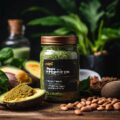The Rise of Plant-Based Milks: A Compassionate Choice
In recent years, we’ve witnessed a remarkable shift in the way we think about our food and drink choices. More and more people are embracing plant-based alternatives, not just for their health benefits, but also out of compassion for animals and concern for the environment. One area where this change is particularly noticeable is in the world of milk alternatives. From soy and almond to oat and hemp, the variety of plant-based milks available today is truly astonishing.
As we explore these alternatives, it’s important to approach the topic with an open mind and a spirit of curiosity. While nutritional content is certainly important, let’s remember that our choices can have far-reaching impacts on animal welfare, environmental sustainability, and even our own sense of wellbeing. So, let’s dive into the world of alternative milks with a focus on two key nutrients: protein and calcium.
Soy Milk: The Protein Powerhouse
When it comes to protein content, soy milk often leads the pack among plant-based alternatives. A typical cup of soy milk contains about 7-8 grams of protein, which is comparable to cow’s milk. This makes soy milk an excellent choice for those looking to maintain or increase their protein intake while moving away from animal products.
But beyond the numbers, there’s a beautiful story of sustainability and compassion behind soy milk. Soy farming, when done responsibly, can be a more environmentally friendly option compared to dairy farming. By choosing soy milk, we’re not only nourishing our bodies but also showing kindness to our planet.
Almond Milk: Light and Refreshing
Almond milk has become incredibly popular in recent years, loved for its light, nutty flavor. While it’s lower in protein compared to soy milk (typically 1-2 grams per cup), it’s often fortified with calcium to levels similar to or even higher than cow’s milk.
What’s truly heartwarming about almond milk is how it represents our collective desire to explore gentler alternatives. The rise of almond milk has sparked important conversations about water usage and bee populations, leading to more sustainable farming practices. This shows how our choices as consumers can drive positive change in the world.
Oat Milk: The Creamy Comfort
Oat milk has taken the world by storm, beloved for its creamy texture that makes it perfect for coffee and baking. In terms of protein, it usually falls between soy and almond milk, with about 3-4 grams per cup. Many brands fortify their oat milk with calcium and other nutrients to match or exceed the levels found in cow’s milk.
What’s particularly inspiring about oat milk is its potential for sustainability. Oats are a hardy crop that can be grown in various climates with relatively low environmental impact. By choosing oat milk, we’re supporting a food system that’s kinder to our planet.
Comparing Calcium Content
When it comes to calcium, it’s important to note that many plant-based milks are fortified to provide levels similar to or even higher than cow’s milk. This is a beautiful example of how innovation can help us meet our nutritional needs while aligning with our values of compassion and sustainability.
Here’s a general comparison of calcium content in different milk alternatives (per cup):
- Cow’s milk: 300-400 mg
- Fortified soy milk: 300-400 mg
- Fortified almond milk: 300-450 mg
- Fortified oat milk: 300-400 mg
Remember, these are general ranges and can vary by brand. Always check the label for specific nutritional information.
Making Compassionate Choices
As we compare these alternatives, it’s crucial to remember that there’s no one-size-fits-all solution. The best choice for you will depend on your individual nutritional needs, taste preferences, and personal values. What’s truly important is that we’re taking steps towards more compassionate and sustainable choices.
Whether you choose soy milk for its protein content, almond milk for its light refreshing taste, or oat milk for its creamy texture, know that you’re part of a growing movement of people who are thinking critically about their food choices and their impact on the world.
Let’s approach this journey with kindness – both to ourselves and to our planet. Every small choice we make can ripple out to create positive change. So, the next time you pour a glass of plant-based milk, take a moment to appreciate the compassion and innovation that went into creating that alternative.
FAQ: Alternative Milks and Nutrition
1. Are plant-based milks nutritionally equivalent to cow’s milk?
While plant-based milks can be excellent alternatives, their nutritional profiles differ from cow’s milk and from each other. Many are fortified to provide similar levels of calcium and vitamins, but protein content can vary. It’s important to choose based on your individual nutritional needs and to read labels carefully.
2. Can I get enough calcium from plant-based milks?
Yes, many plant-based milks are fortified with calcium to levels similar to or even higher than cow’s milk. Always check the label to ensure you’re choosing a fortified variety if calcium intake is a concern for you.
3. Which plant-based milk has the most protein?
Among common plant-based alternatives, soy milk typically has the highest protein content, often comparable to cow’s milk. However, protein content can vary by brand, so it’s always best to check the nutrition label.
4. Are there any potential allergens in plant-based milks?
Yes, some people may be allergic to the base ingredients in plant milks, such as soy, almonds, or oats. If you have known allergies, always check ingredient lists carefully and consult with a healthcare professional if you’re unsure.
5. How do plant-based milks compare in terms of environmental impact?
Generally, plant-based milks have a lower environmental impact than dairy milk in terms of greenhouse gas emissions and land and water use. However, the specific impact varies depending on the base ingredient and production methods. Oat and soy milk are often considered among the most environmentally friendly options.









